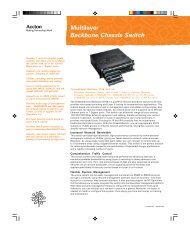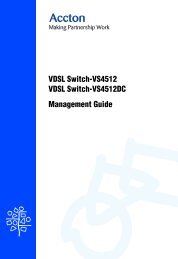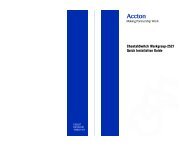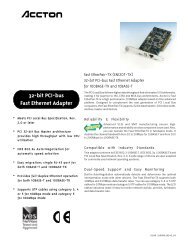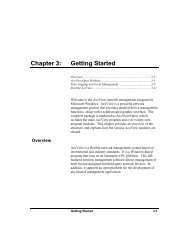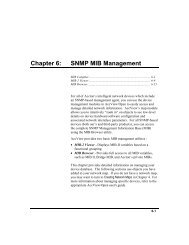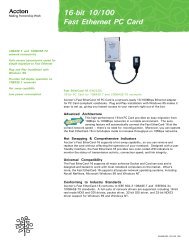Setting up Network Connections
Setting up Network Connections
Setting up Network Connections
You also want an ePaper? Increase the reach of your titles
YUMPU automatically turns print PDFs into web optimized ePapers that Google loves.
Chapter 3:<strong>Setting</strong> <strong>up</strong> <strong>Network</strong> <strong>Connections</strong>Special Architecture Used for the Fast EtherHub 3500 StackMulti-Segment ArchitectureThe Fast EtherHub 3500 system s<strong>up</strong>ports multi-segmentconfiguration through the FlexBus cabling. Three Ethernetsegments (i.e., separate collision domains) are embedded in thehub’s FlexBus port (i.e., the stack’s backplane). You canchoose to attach a hub to one of these segments, or to leave itisolated except for the management channel. Nodes attached toa specific segment (e.g., Segment 1) can only communicatewith nodes attached to the same segment (unless the segmentsare interconnected with a device such as an Ethernet switch).This type of architecture makes the system more flexible,provides better traffic load sharing and data protection,improves network bandwidth utilization, and simplifiestroubleshooting.Carefully plan your network set<strong>up</strong> to make this architecturework well for your system. Form a common domain fordevices that need to frequently communicate with each otherby attaching them to the same segment. In this way you canarrange network resources to balance traffic and therebyincrease overall network efficiency.To combine the segments into an interconnected network (whileat the same time retaining the higher effective bandwidth andsegment integrity provided by the multi-segment architecture),attach each segment to a switch or similar interconnection device,such as one of Accton’s Fast Ethernet Switches.<strong>Setting</strong> Up <strong>Network</strong> <strong>Connections</strong> 3-1
Fast EtherHub 3500 System User’s GuideFlexBus 3500 Management LinkThe management link in a chain of cascaded hubs must beconnected to manage the stack as a single unit. This means thatonly hubs connected using the FlexBus can be controlled by anSNMP management agent (i.e., Fast EtherHub-12mi). At most, 6hubs can be managed and linked together using the FlexBusconnection.Hub ID <strong>Setting</strong>In a stacked system, each hub should have a unique ID numberto identify itself. Each hub automatically sets an ID number ifattached to an SNMP management agent through the FlexBus port(i.e., Fast EtherHub-12mi). When a new hub is inserted in thestack, the next available hub identifier is assigned to the new hub(i.e., the identifier numbers are not changed for previouslyconfigured hubs). When the stack includes a management agent,you can also set hub IDs using the on-board configurationprogram. Refer to Configuring Hub Parameters in Chapter 4 for moreinformation.Using Management AgentsThe Fast EtherHub-12mi SNMP includes an SNMP managementagent. To add SNMP functionality to the entire stack, this hubtype must be included in the stack. To provide in-band access tothe agent you must also attach your network management stationto a the segment that includes the management agent.3-2 <strong>Setting</strong> Up <strong>Network</strong> <strong>Connections</strong>
Fast EtherHub 3500 System User’s GuideThe on-board configurationprogram only provides accessto the private MIB. To gain fullSNMP functionality, you mustuse optional networkmanagement software (e.g.,AccView/Open).Multiple AgentsYou may include multiple agents in a stack. To provide a failsafeback<strong>up</strong> management agent, include it in the same segmentwith the Master agent. You may also use several active agentsin the same stack. However, they must be attached to differentsegments and have unique IP addresses.SNMP Back<strong>up</strong> AgentThe Fast EtherHub 3500 system s<strong>up</strong>ports a back<strong>up</strong> function forthe management agent. This special function allows the stack tohave two or more SNMP network management agents attachedto the same segment, wherein one agent is configured as theMaster agent and the other(s) as a Slave (i.e., Back<strong>up</strong>) agent.The agent in slave mode behaves as a Fast EtherHub-12i. But ifthe Master agent fails, the Slave agent takes over its functionsusing the latest data mirrored from the Master, including its IPaddress. Note that to manage the stack out-of-band after theSlave has assumed control, you must plug your PC or modeminto the Serial port of the Slave agent. If you are using optionalnetwork management software, just ensure that your networkmanagement station can access the new control agent via itscurrent network connection.Note: If redundant agents are placed in a segment, the system will setthe agent closest to the top of the stack as the master, and the othersas slaves. If more than one slave exists in a segment, the slave higher<strong>up</strong> in the FlexBus chain will be chosen to function as the Master if it fails.<strong>Setting</strong> Up <strong>Network</strong> <strong>Connections</strong> 3-3
Fast EtherHub 3500 System User’s GuidePort Back<strong>up</strong> FunctionThe Fast EtherHub 3500 system s<strong>up</strong>ports a port back<strong>up</strong>function (i.e., a redundant link). A hub system can have <strong>up</strong> to18 pairs of redundant links. These links are configurable usingthe in-band or out-of-band management program. When aprimary link fails, the secondary (i.e., back<strong>up</strong>) linkautomatically takes over.Notes: 1. To prevent traffic from looping, the primary port is enabled and theback<strong>up</strong> port disabled. If the system is functioning normally, the Linkindicator for the primary port and the Partition indicator for theback<strong>up</strong> port will be on.2. It is common practice to attach these links to the same physicaldevice (e.g., two separate adapter cards on a critical server).However, to provide more flexibility, this is not enforced by theconfiguration program.Security FeaturesIntrusion ProtectionAny repeater port on the hub can be configured with a preferredsource address. If an unauthorized intruder is detected, thenetwork management station can be notified, or a trap can besent and the port disabled.3-4 <strong>Setting</strong> Up <strong>Network</strong> <strong>Connections</strong>
Sample <strong>Network</strong> ConfigurationsFast EtherHub 3500 System User’s GuideThe Fast EtherHub 3500 series stackable hubs are designed toprovide flexibility in configuring network connections. Thishub can be used as a simple stand-alone hub or connected toother network interconnection devices in various configurations.This section includes sample applications, most of which takeadvantage of the multi-segment architecture. Pay attention tothe examples that illustrate how to segment a hub stack. Thisprocedure can extend network bandwidth <strong>up</strong> to 300 Mbps.Attaching the Stack to One SegmentYou can attach all the hubs in a stacked system to the samesegment. In this example, a stacked system using the FlexBusport connection is connected to segment 1.Putting all hubs in the same segment gro<strong>up</strong>s all nodes attachedto the stack in a single collision domain. All Ethernet framestransmitted by any node are seen by every other node in thestack. For a heavily loaded network, you can significantlyimprove performance by configuring the stack into separatesegments as shown in the next example.SEGMENT 1SEGMENT 1ID1ID2EtherHub3500EtherHub3500 HUBMANAGEMENTCHANNELSEG. LINK 1SEGMENT 1ID3EtherHub3500 HUBSEG. LINK 2SEG. LINK 3SEGMENT 1ID4EtherHub3500 HUBSEGMENT 1ID5EtherHub3500 HUBSEGMENT 1ID6EtherHub3500 HUBFlexBus 3500 CableFigure 3-1 Attaching All Hubs in Stack to One Segment<strong>Setting</strong> Up <strong>Network</strong> <strong>Connections</strong> 3-5
Fast EtherHub 3500 System User’s GuideAttaching the Stack to Multiple SegmentsThis example shows 3 independent Ethernet LANs in a stackedsystem. Hubs 1 and 2 are attached to segment 1, while hubs 3and 4 are attached to segment 2, and hubs 5 and 6 are attachedto segment 3.This configuration serves to both balance the network load andimprove performance. Using three separate segments provides300 Mbps of Ethernet bandwidth to the overall stack. Moreover,using a segmented configuration serves to confine the effects ofheavy loading or network problems to a single segment.SEGMENT 1SEGMENT 1ID 1ID 2EtherHub3500 AGENTEtherHub3500 HUBMANAGEMENTCHANNELSEG. LINK 1SEGMENT 2ID 3EtherHub3500 HUBSEG. LINK 2SEG. LINK 3SEGMENT 2ID 4EtherHub3500 HUBSEGMENT 3ID 5EtherHub3500 HUBSEGMENT 3ID 6EtherHub3500 HUBFlexBus 3500 CableFigure 3-2 Attaching Hubs in Stack to Three SegmentsTrafficin each segment is restricted to that segment and cannot passto another segment without a device such as a SmartExtender Moduleor one of Accton’s Fast Ethernet Switches to link them.3-6 <strong>Setting</strong> Up <strong>Network</strong> <strong>Connections</strong>
Fast EtherHub 3500 System User’s GuideIsolating Specific Hub <strong>Connections</strong>You can interconnect or isolate the hubs in a stack using amulti-segment configuration. In a stacked system, some hubsmay be connected to a segment while others are isolated (notattached to any segment). In this example, hubs 1 and 2 areattached to segment 1, while hubs 3 and 4 are attached tosegment 2. However, hubs 5 and 6 are not connected to anysegment. These hubs form isolated segments. With carefulplanning, you can restrict access for specific user gro<strong>up</strong>s torequired connections only.SEGMENT 1SEGMENT 1ID 1ID 2EtherHub3500 AGENTEtherHub3500 HUBMANAGEMENTCHANNELSEG. LINK 1SEGMENT 2ID 3EtherHub3500 HUBSEG. LINK 2SEG. LINK 3SEGMENT 2ID 4EtherHub3500 HUBISOLATEDID 5EtherHub3500 HUBISOLATEDID 6EtherHub3500 HUBFlexBus 3500 CableFigure 3-3 Linking Part of the Stacked Hubs to a SegmentWhenhubs are isolated, they cannot communicate with any otherdevice in the stack via the FlexBus.<strong>Setting</strong> Up <strong>Network</strong> <strong>Connections</strong> 3-7
Fast EtherHub 3500 System User’s GuideIsolating Each HubIn this example, each hub in the stack is an independentsegment (i.e., isolated collision domain). Hubs 2 to 6 are notconnected to any of the 3 segments embedded in the FlexBus3500 cable.ID 1ID 2ID 3ID 4EtherHub3500 AGENTEtherHub3500 HUBEtherHub3500 HUBEtherHub3500 HUBMANAGEMENTCHANNELSEG. LINK 1SEG. LINK 2SEG. LINK 3ID 5ID 6EtherHub3500 HUBEtherHub3500 HUBFlexBus 3500 CableFigure 3-4 Stacked Hubs Not Linked to a SegmentIfthe Fast EtherHub-12mi is isolated from the backplane (i.e., notattached to any of the 3 segments), the stack can still be managedwith the out-of-band configuration program via the managementchannel embedded in the FlexBus 3500 cable.3-8 <strong>Setting</strong> Up <strong>Network</strong> <strong>Connections</strong>
Fast EtherHub 3500 System User’s GuideExtending the <strong>Network</strong> with Alternate <strong>Connections</strong>You can extend your network by connecting any of the hubs ina stacked system to other compatible hubs via theSmartExtender Module. In the diagram below, a stand-alonehub is connected to hub 3 in the stacked system using theextender module. However, remember that the Fast EtherHub3500 Agent can only manage hubs connected to it through theFlexBus connection.SEGMENT 1SEGMENT 1ID 1ID 2EtherHub3500 AGENTEtherHub3500 HUBMANAGEMENTCHANNELSEG. LINK 1SEGMENT 2ID 3EtherHub3500 HUBSEG. LINK 2SEG. LINK 3SEGMENT 2ID 4EtherHub3500 HUBSEGMENT 3ID 5EtherHub3500 HUBSEGMENT 3ID 6EtherHub3500 HUBEtherHub3500FlexBus 3500 CableFigure 3-5 Linking Stacked Hubs to Unmanaged Hubsvia the SmartExtender Module<strong>Setting</strong> Up <strong>Network</strong> <strong>Connections</strong> 3-9
Fast EtherHub 3500 System User’s GuideLinking the Stack to a Management StationIn a stacked system, connect the in-band management workstationto the same segment that the management agent is attached to. Inthis example, the management agent is attached to segment 1.Thus, the in-band management workstation (e.g., a PC runningAccView/Open) should also be connected to segment 1.SEGMENT 1SEGMENT 1SEGMENT 2EtherHub 3500 AGENTEtherHub3500 HUBEtherHub3500 HUBMANAGEMENTCHANNELSEG. LINK 1SEG. LINK 2SEG. LINK 3SEGMENT 2EtherHub3500 HUBSEGMENT 3EtherHub3500 HUBACCVIEWSEGMENT 3EtherHub3500 HUBAccView Station(Segment 1)FlexBus 3500 CableFigure 3-6 Linking Stacked Hubs to a <strong>Network</strong> Management Station3-10 <strong>Setting</strong> Up <strong>Network</strong> <strong>Connections</strong>
Fast EtherHub 3500 System User’s GuideInterconnecting the SegmentsThe 3 segments within a stacked system can be combined into aninterconnected network using the SmartExtender Modules. Forexample, you can connect all the segments in the stack using justtwo extender modules as shown below. Using this approach, yo<strong>up</strong>rovide a higher bandwidth by using three separate collisiondomains, but still permit stations to communicate with nodes inother segments, as required.SEGMENT 1ETHERHUB3500 AGENTACCVIEWETHERHUB3500 HUBSEGMENT 1Inter-Segment LinkETHERHUB3500 HUBSEGMENT 2AccView StationSEGMENT 2ETHERHUB3500 HUBInter-Segment LinkSEGMENT 3ETHERHUB3500 HUBSEGMENT 3ETHERHUB3500 HUBFlexBus 3500 CableFigure 3-7 Linking Segments in a Stacked System<strong>Setting</strong> Up <strong>Network</strong> <strong>Connections</strong> 3-11
Fast EtherHub 3500 System User’s GuideConnecting Remote StacksFast EtherHub stacks can be connected by using theSmartExtender Modules. For example, you can connect twostacks by running a cable from the extender module in one stackto any station port in a remote stack. When using twisted-paircable, the maximum cable length is 100 meters. Also note thatwhen you connect directly to a repeater bus in this manner, thetransmission mode is limited to half d<strong>up</strong>lex.You can connect stacks over an even greater distance if you runfiber optic cable between SmartExtender Modules in both stacks.When you connect to switching ports at both ends of the cable, thetransmission mode is automatically set to full d<strong>up</strong>lex, allowingyou can run a fiber optic link <strong>up</strong> to 2 kilometers. However, if youmust operate at half d<strong>up</strong>lex, then the maximum separationbetween stacks is 412 meters .STACK 1ETHERHUB3500 HUBSTACK 1ETHERHUB3500 HUBRemote Stack Link (Up to 100 meters with twisted-pair cable)ETHERHUB3500 HUBSTACK 2STACK 2ETHERHUB3500 HUBRemote Stack Link (Up to 2 kilometers with fiber optic cable)ETHERHUB3500 HUBSTACK 3STACK 3ETHERHUB3500 HUBFlexBus 3500 CableFigure 3-8 Connecting Remote Stacks3-12 <strong>Setting</strong> Up <strong>Network</strong> <strong>Connections</strong>
Fast EtherHub 3500 System User’s GuideOperating in the Novell NetWare IPX EnvironmentIf you’re using Novell NetWare server as your <strong>Network</strong>Operating System, you can have <strong>up</strong> to 3 LAN adapters installedin the File Server. With this type of set<strong>up</strong>, the network isperceived as logically divided into different collision domains,but the File Server is still accessible by all nodes. As shown inthe following figure, three LAN adapters installed in a NetWareserver are each connected to a hub in the stack with IPXProtocol bound to each adapter.The first adapter is attached to segment 1 with IPX networknumber 102; the second adapter is attached to segment 2 withIPX network number 103; and the third one is connected tosegment 3 with IPX network number 104.SEGMENT 1SEGMENT 1EtherHub 3500 AgentEtherHub 3500 HubIPX net number=102SEGMENT 1SEGMENT 2SEGMENT 2EtherHub 3500 HubEtherHub 3500 HubIPX net number=103SEGMENT 2EtherHub 1500 HubSEGMENT 3IPX net number=104NOVELL NetWare ServerEtherHub 1500 HubSEGMENT 3SEGMENT 3Figure 3-9 System Applied in Novell NetWare IPX Environment<strong>Setting</strong> Up <strong>Network</strong> <strong>Connections</strong> 3-13
Fast EtherHub 3500 System User’s GuideOperating in the TCP/IP EnvironmentIn TCP/IP Internet environment, gateways are used to improveperformance and regulate network traffic by confining mostnetwork activity to their respective local network, and stillmaintain communication links among LANs of the same ordifferent architectures. You can implement an IP subnetgateway if you have an IP network address (e.g., 140.20.0.0).For example, in a Fast EtherHub 3500 system (as shown in thefigure below), you can attach three LAN adapters to yoursubnet gateway using a UNIX server. Perform the followingsteps.Assign IP addresses from 140.20.1.1 ~ 140.20.1.254 to nodes onsegment 1, and set their subnet mask to 255.255.255.0.Assign IP addresses from 140.20.2.1 ~ 140.20.2.254 to nodes onsegment 3, and set their subnet mask to 255.255.255.0.Assign IP addresses from 140.20.3.1 ~ 140.20.3.254 to nodes onsegment 2, and set their subnet mask to 255.255.255.0.Assign IP address 140.20.1.10 to the first adapter, 140.20.2.20 to thesecond adapter, and 140.20.3.30 to the third one.SEGMENT 1EtherHub 3500 AgentSEGMENT 1SEGMENT 1EtherHub 3500 HubIP = 140.20.1.10SEGMENT 2SEGMENT 2EtherHub 3500 HubEtherHub 3500 HubSEGMENT 2IP = 140.20.2.20IP =140.20.3.30SEGMENT 3SEGMENT 3EtherHub 3500 HubEtherHub 3500 HubSEGMENT 3NOVELL NetWare Server,Unix Server(e.g., SCO Unix)SubnetMask = 255.255.255.0 for all segmentsFigure 3-10 System Applied in TCP/IP Environment3-14 <strong>Setting</strong> Up <strong>Network</strong> <strong>Connections</strong>
Fast EtherHub 3500 System User’s GuideConnecting to the <strong>Network</strong> BackboneThe stack can be connected to the network backbone by attachingit to a device such as a Fast Ethernet switch. The following figureshows a direct connection from the stack’s daisy-chain port to a100BASE-TX switch which is serving as collapsed networkbackbone.SEGMENT 1ETHERHUB3500 AGENTACCVIEWSEGMENT 1SEGMENT 2ETHERHUB3500 HUBETHERHUB3500 HUBAccView StationSEGMENT 2ETHERHUB3500 HUBSEGMENT 3SEGMENT 3Collapsed BackboneETHERHUB3500 HUBETHERHUB3500 HUBFast Ethernet SwitchFlexBus 3500 CableLinks to <strong>Network</strong>Figure 3-11 Connecting to the <strong>Network</strong> Backbone<strong>Setting</strong> Up <strong>Network</strong> <strong>Connections</strong> 3-15




